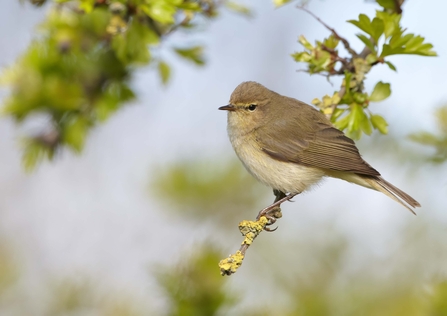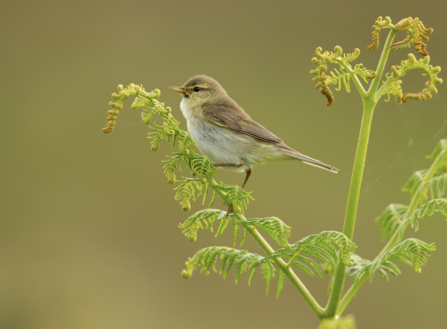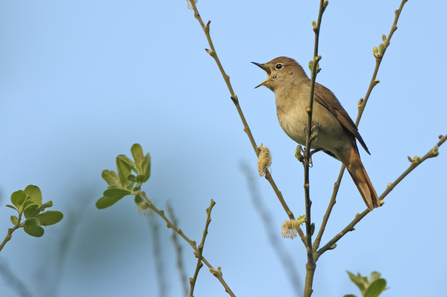Estimating and recording the location of the birds by their call is difficult, due to the lack of solid landmarks through the scrubland. Cuckoos can be particularly disorientating in their call directions and how much they move, but they can be seen, sometimes calling in flight and sometimes in pairs high up in trees. There are many nightingales which sit singing deep down in the scrub and given how close you are, it seems impossible that you just can’t see them. Other songbirds can be seen flitting around in the dense vegetation, but overwhelmingly our surveys are about unpicking the dawn chorus. Our aim is to locate the same bird species singing around the same spot on three occasions, two weeks apart, as an indication of a breeding territory. Our surveys start in the early mornings, 30 minutes after sunrise, from around 6am in late March and by midsummer this is closer to 5am.
Breeding bird surveys at Strawberry Hill

Chiffchaff ©Richard Steel/2020VISION
This year we started on 29th March when the bushes were bare of leaves, allowing a bit of visibility. The resident song thrushes were singing strongly plus a few blackcaps, green-, gold- and bullfinches were active, but at this stage it was the chiffchaffs which were setting up their territories. Each species seems to have its peak, and at this early stage there were chiffchaffs everywhere, sometimes on both sides of the path every 50m or so. The next big wave in mid-April were the arriving summer migrant willow warblers. The scrub in parts of the site now seems to be in prime condition for willow warblers, and the numbers from April and for the rest of the season were amazing, doubling compared to last year and with new breeding zones being utilised. Also, from mid-April we heard the first nightingales and lesser whitethroats and, in the more open scrub and grasslands, whitethroats and grasshopper warblers. The fresh green leaves and bursting blossom of the blackthorn and hawthorn in April make for magical scenes with the low sun and early morning shadows.

Willow warbler Ben Hall 20/20Vision
Nightingales reached their peak for territorial singing in late April and early May; with the willow warblers still going strong and whitethroats and lesser whitethroats building up, this was one of the busiest and most exciting times. The chiffchaffs and other resident species became quieter as they were nesting, and through May the nightingales and willow warblers did the same. From early May the first turtle doves arrived from their later migration, and we started to hear their purring calls; mobile and elusive and calling only briefly at this early stage, they felt like the spirits of the scrubland, hard to pin down and seemingly impossible to see. As May progressed the turtle doves did settle down and became easier to map and sometimes to see them. Garden warblers, never in big numbers, had their peak quite late in May.

Nightingale © Chris Gomersall/2020VISION
By early June we could still find some nightingales but with weaker song and more of the ‘grunt’ they use to communicate between each other and their young. The final survey on 22nd June saw the approaching end of the breeding season. The turtle doves were still calling and in numbers over double of last year. There was a surprising late reappearance, for numerous calling lesser whitethroats, goldfinches and other seed eaters increasingly moving in and around to feed. The cuckoos were still active and a few of everything were still around and calling, possibly unsuccessful males or those trying for a second brood. There was a sense of the landscape, the birds and us surveyors feeling a combination of exhaustion and in our case, satisfaction. However, the territories we counted only show the numbers present and trying to breed. We don’t know if they have unless we can see the young, which is one of the great challenges of this incredible place; this year, on additional visits at the end of August both adult and juvenile turtle doves were seen.
Written by Stephen James, Volunteer, BCN Wildlife Trust
